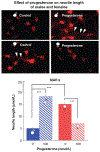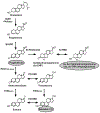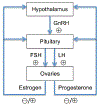Reproductive Steroid Regulation of Mood and Behavior
- PMID: 27347888
- PMCID: PMC6309888
- DOI: 10.1002/cphy.c150014
Reproductive Steroid Regulation of Mood and Behavior
Abstract
In this article, we examine evidence supporting the role of reproductive steroids in the regulation of mood and behavior in women and the nature of that role. In the first half of the article, we review evidence for the following: (i) the reproductive system is designed to regulate behavior; (ii) from the subcellular to cellular to circuit to behavior, reproductive steroids are powerful neuroregulators; (iii) affective disorders are disorders of behavioral state; and (iv) reproductive steroids affect virtually every system implicated in the pathophysiology of depression. In the second half of the article, we discuss the diagnosis of the three reproductive endocrine-related mood disorders (premenstrual dysphoric disorder, postpartum depression, and perimenopausal depression) and present evidence supporting the relevance of reproductive steroids to these conditions. Existing evidence suggests that changes in reproductive steroid levels during specific reproductive states (i.e., the premenstrual phase of the menstrual cycle, pregnancy, parturition, and the menopause transition) trigger affective dysregulation in susceptible women, thus suggesting the etiopathogenic relevance of these hormonal changes in reproductive mood disorders. Understanding the source of individual susceptibility is critical to both preventing the onset of illness and developing novel, individualized treatments for reproductive-related affective dysregulation. © 2016 American Physiological Society. Compr Physiol 6:1135-1160, 2016e.
Copyright © 2016 John Wiley & Sons, Inc.
Figures








References
-
- Ahokas A, Kaukoranta J, Wahlbeck K, Aito M. Estrogen deficiency in severe postpartum depression: Successful treatment with sublingual physiologic 17beta-estradiol: A preliminary study. J Clin Psychiatry 62: 332–336, 2001. - PubMed
-
- Akwa Y, Purdy RH, Koob GF, Britton KT. The amygdala mediates the anxiolytic-like effect of the neurosteroid allopregnanolone in rat. Behav Brain Res 106: 119–125, 1999. - PubMed
-
- Allen JJB, Urry HL, Hitt SK, Coan JA. The stability of resting frontal electroencephalographic asymmetry in depression. Psychophysiology 41: 269–280, 2004. - PubMed
-
- American Psychiatric Association, DSM-5 Task Force. Diagnostic and Statistical Manual of Mental Disorders: DSM-5. Arlington, VA: American Psychiatric Association, 2013.
Publication types
MeSH terms
Substances
Grants and funding
LinkOut - more resources
Full Text Sources
Other Literature Sources
Medical

